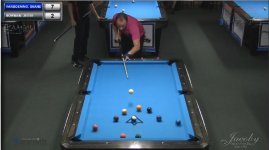Here Shane puts on a breaking clinic. Notice how the cueball reacts. Notice how the top 3 balls react. Awesome stuff.
https://youtu.be/e3YSOu_ew4M
Here are some stats on that match (based on Pool-Trax data at the time), won by Shane 50 - 21.
Breaker made at least one ball and did not foul:
• Shane Van Boening -- 88% (43 of 49)
• Nikos Ekonomopoulos -- 45% (10 of 22)
Breaker won game:
• SVB -- 73% (36 of 49)
• NE -- 36% (8 of 22)
Break-and-run games:
• SVB -- 53% (26 of 49) ... one 5-pack, one 4-pack, two 3-packs, three 2-packs, and five singles
• NE -- 18% (4 of 22) ... one 2-pack and two singles
Run-outs on successful breaks:
• SVB -- 60% (26 of 43)
• NE -- 40% (4 of 10)
Balls on the break:
• SVB -- average 1.7 ... dry 3 times (including 1 foul), one ball 18 times (including 2 fouls), two balls 20 times (including 1 foul), three balls 7 times, and five balls once
• NE -- average 0.6 ... dry 12 times, one ball 8 times, two balls once, and three balls once
